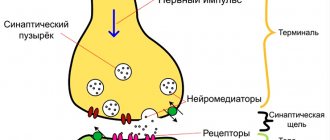It is one of the most complex brain pathologies. Most often associated with age-related changes caused by cell death that occurs due to age-related changes.
Age-related changes in the body provoke the onset of many diseases. One of which is Pick's disease. With this variant of senile dementia, disturbances occur in areas localized in the frontal and temporal lobes of the brain. This acquired senile dementia is characterized by behavioral disturbances. The patient's instincts are disinhibited, and cognitive functions collapse.
This type of senile dementia was first described at the end of the 19th century, in 1892, by psychiatrist Arnold Pick. At the initial stages of studying the disease, it was recognized as one of the manifestations of senile dementia. As the study progresses, Pick's disease is identified as a separate pathology. Until now, the pathology has been little described. It is diagnosed in 1-2% of older patients. The diagnosis is not always established immediately. For a long time, its manifestations were attributed to another variant of senile dementia, Alzheimer's disease. The difference is the localization of areas of death in the brain. If in Alzheimer's disease they are not strictly localized, the entire brain is affected; in Pick's disease the temporal and frontal lobes are affected.
A significant difference between the diseases is the absence of disturbances in the functioning of the cardiovascular system. Symptoms of the formation of plaques that occur during inflammatory processes do not appear. Due to death, thinning of the cerebral cortex occurs. The size of the cerebral ventricles increases. The distance between them practically disappears.
Manifestations start with speech disorders. Pick's disease causes behavioral changes in the patient. At the third stage, total dementia is noted.
Pick's disease is treatable, but age-related changes in the brain cannot be completely cured. The process of cell death is not completely stopped by medications.
Causes and risk factors for Pick's disease
Modern research shows that patients aged 50-60 years and older are susceptible to this type of senile dementia. Recently, the disease has been actively studied. But all the research so far does not allow us to accurately determine the reasons for the onset of age-related changes in the temporal and frontal lobes. Some common factors found in patients affected by pathology have been identified:
- Hereditary factor. In most cases, close relatives of the patient suffered from Pick's disease.
- The onset of degenerative processes is caused by a serious head injury, which causes the death of neurons, which leads to irreversible changes in the cerebral cortex.
- Neuronal damage caused by exposure to chemicals caused by exposure to heavy metals, their excessive concentration. The list of factors includes the constant impact of alcohol on the human body.
- Pick's disease is often a consequence of mental disorders. The risk group includes all patients under the supervision of a psychiatrist.
- A risk factor is the constant use of psychotropic drugs.
- A hypovitamin condition can lead to the onset of the disease.
A feature of the disease is the absence of a guaranteed start of Pick's disease, even with a combination of all these factors. Often, the death of neurons is caused by factors that doctors are currently unable to clearly identify.
Important: Treatment for Pick's disease is ineffective. Modern methods are not able to stop degenerative processes, which lead to complete dementia 5-6 years after the first episode.
The atrophic process continues continuously. It affects subcortical structures and cortex. Inflammation and vascular disorders are not detected.
During diagnosis, specialized studies are carried out to separate Pick's disease from other diseases with similar symptoms. Primarily for Alzheimer's disease. Senile dementia is also characterized by similar symptoms. Many symptoms are also present with intracerebral tumors.
Diagnosis in most cases is performed already at the second stage of a complex disease. In many cases, the appeal comes from the patient’s relatives who complain about his antisocial behavior.
In order to accurately determine the lesion, a personal examination of the patient by a specialist is carried out. In its course, the development of Pick's disease allows us to assume:
- aggressive behavior;
- failure of the patient to comply with hygiene skills;
- a penchant for crude humor appears;
- hypersexuality is noted.
Special tests are prescribed to identify concomitant diagnoses. An accurate diagnosis is established by analyzing the growing symptoms. Additionally, studies of the cerebral cortex are carried out using MRI or CT. Magnetic resonance therapy is preferable in this case. During this procedure, the brain is imaged layer by layer, helping to identify areas of damage. Such a thorough examination at the earliest stages allows specialists to determine the type of Pick's disease that the patient suffers from and to identify the exact location of the lesions.
Another study that helps determine the onset of the disease is performing an EEG (encephalography). The study determines the degree of brain activity. In many cases, EEG data is checked and confirmed by CT or MRI. Using all of the above research options provides the most complete picture.
It is important to note that if it is possible to conduct only one of the types of proposed studies, preference is given to MRI. It gives the most complete picture of the condition of the internal organs.
Conducting research ensures that errors in diagnosis are eliminated, allowing Pick's disease to be separated from other degenerative brain lesions at a very early stage. Primarily for Alzheimer's disease.
Often the classic form is also confused with Pick's disease, which is diagnosed in children. Despite the similarity of names, these are different diagnoses. They require different treatment methods.
The main difference is the age of the patients. Diagnosis is carried out with special care at the onset of pathology in patients in the age group of 30 to 40 years. Age-related changes begin in most situations after 50. But additional factors are taken into account. For example, lifestyle and type of work performed. Early senile changes may be associated with the death of neurons, which is provoked by frequent damage to the cerebral cortex by active chemicals, mechanical stress, alcohol and other factors. The specialist receives all this data during a personal conversation during a preliminary examination with the patient himself or his relatives. Pick's disease at an early age negatively affects the quality of life and requires complex therapy.
Causes of the disease
The etiology of Pick's disease is still unclear. Although there are “familial” episodes of the disease, more often it is not transmitted from parents to children, but is diagnosed in siblings. However, the hereditary factor has been completely refuted.
Etiological factors are considered:
- negative effects on humans, in particular on the brain, of chemicals;
- incorrect dosage and/or frequent use of anesthesia;
- mental disorders.
Not the main, but provoking factor can be considered a lack of B vitamins, traumatic brain injuries, and intoxication. Some experts believe that a provoking factor may also be a failure in the metabolism of tau protein, a component that is an element of the cell membranes of neurons.
In this disease, brain cells undergo atrophy and destruction - they lose functionality, decrease in size or are completely destroyed. Regardless of the combination of symptoms, it is always accompanied by dementia due to a violation of the higher function of the cerebral cortex. In this case, dementia is acquired.
The risk group includes patients over 50–55 years of age, females, and in whose family there are cases of this type of dementia. Traumatic brain injuries do not serve as a provoking factor for infection, but significantly accelerate and aggravate the course of the disease.
The disease can be diagnosed in younger people as early as 40–45 years of age. But at this age it progresses slowly, the symptoms are mild, so patients rarely see a doctor, and at the time of diagnosis, the second stage is already detected. The onset most often is not so pronounced and can manifest itself in increased anxiety, loss of control over one’s actions, and depressive states, which the patients themselves usually justify as stress or other similar reasons.
Stages of Pick's disease
A feature of this lesion of the cerebral cortex is a gradual increase in symptoms, which cannot be stopped. Development occurs from the degradation of social functions to physiological disorders, expressed in memory loss and the cessation of the ability to perform other tasks.
- At the first stage, a change in behavior is observed. A person may suddenly leave his job. Damage to the basal frontal lobes provokes activation of selfishness, disinhibition of desires, loss of criticism, sexual disinhibition, physiological needs can be coped with in an environment not intended for this. It is easy to identify lesions affecting the right hemisphere by the appearance of euphoria. When the right lobes are affected, the patient becomes depressed. In case of damage to convexial surfaces, leading to atrophy, the patient experiences emotional dullness. The death of other areas can provoke indifference, spontaneity and other atypical forms of behavior.
- At the second stage, focal symptoms increase, manifesting themselves in the form of agnosia. Patients have hearing and speech impairments, they lose tactile and visual perception. Due to moderate agnassia at this stage, complex motor acts begin to be disrupted. There is a gradual disintegration of speech from the use of stereotypical constructions when constructing phrases to the transition to echolalia. The patient can only repeat heard words and syllables. As symptoms increase in the second stage, the patient gradually ceases to clearly understand the purpose of using objects. For example, having received candy as a treat, the patient can unwrap it, throw away the sweet treat and start eating the wrapper.
- The third stage is accompanied by a transition to total dementia. The patient loses the ability to perform any conscious activity, the possibility of recognition disappears. The patient feels severe weakness, practically losing the ability to move independently. However, Pick's disease is not accompanied by paralysis. At the thermal stage of the third stage, the patient develops a vegetative coma.
All stages of the disease, with an unfavorable course, develop within 3-4 years. The use of modern drugs and techniques, the patient’s health status and other factors can extend the duration of the disease to 7-10 years.
In medical practice, the disease differs depending on the location of the affected areas:
- in the case of a predominance of atrophy in the frontal part of the brain, most patients suffer primarily from disorders responsible for storing memory;
- atrophy in the temporal lobe causes speech disorders of aphasia;
- when the hypothalamus is affected, patients lose the ability to concentrate, they suffer from psycho-emotional disorders, depression or euphoria.
In medical practice, differences are observed only in the early stages of the lesion. The listed symptoms are combined in cases of simultaneous damage to both lobes of the brain.
Pick's disease in children
Irreversible damage to the cerebral cortex, characteristic of Pick's disease, in most cases affects older people. But in exceptional situations, this complex diagnosis is observed in representatives of other age groups, including children.
The danger lies in family history. In the case of the presence of dementia caused by this diagnosis in relatives, in rare cases, Pick's disease can develop in children. Inheritance occurs according to an autosomal recessive principle. If the disease is diagnosed in one of the parents, the hereditary lesion can occur in a child of either sex. An unfavorable prognosis is given if the pathological gene is present in both parents.
The progression of the pathology occurs in the first weeks of life. At birth, the baby is considered completely healthy.
Manifestations of pathology include:
- the presence of constant nausea, which often leads to vomiting;
- the child has no appetite;
- liver size is increased;
- body weight is rapidly decreasing, the baby is significantly behind in growth compared to peers;
- lymph nodes enlarge;
- pigmentation is observed on the skin;
- The cornea of the eye becomes cloudy.
As a result of a significant increase in the size of the internal organs, the abdomen of a small patient appears disproportionately large.
Pick's disease is incurable regardless of the patient's age. As the child’s symptoms develop, the central nervous system becomes disrupted. This manifests itself in the absence of speech, “humming” in infants, and visual and hearing impairment is diagnosed. The baby may develop seizures, similar to manifestations of epilepsy. Reflex activity in patients increases significantly. In the most difficult cases, when the disease starts in the first months, children rarely survive to one year.
In addition to the classic form of Pick's disease, children may develop:
- visceral type, most often beginning in children aged 6-7 years;
- in adolescence, the juvenile type of Pick's disease begins;
- A special form of Novo Scottia, also most often beginning in the first 20 years.
These types may not be accompanied by neurological disorders. In the juvenile type, children and adolescents experience severe muscle weakness, which can lead to loss of motor activity.
The choice of treatment option for pathology directly depends on the type of disease. The classic type develops rapidly and is fatal within a maximum of five years. Patients with other types can live up to 30 years.
Prevention includes testing with a geneticist for families planning to conceive a child.
1.General information
In the psychoneurological branches of medical science, a special category consists of diseases, the general essence of which is the degeneration of nerve cells - neurons. Performing fundamental control and regulatory functions on the scale of the entire organism, the neural tissue of the spinal cord and brain with the development of such pathological processes loses its inherent complex structure and organization, decreases in volume (atrophies) and copes with the tasks assigned to it increasingly poorly. Most of these diseases are caused by inherited genetic defects, but for some neurodegenerative processes the causes are still completely unclear. In the popular consciousness, such diseases are associated primarily with old age, however, only senile dementia itself can be associated with purely age-related atrophy of the cerebral cortex, while other diseases of this kind begin, as a rule, in adulthood and old age (and sometimes in young), proceeding faster and more catastrophically. Almost all neurodegenerative diseases of the central nervous system (spinal cord and brain), whether focal or diffuse, in the terminal stage lead the patient to a vegetative existence and total dementia (dementia).
Diseases in this group are fortunately quite rare, but published statistics are often contradictory and may be underestimated. At the very least, terms such as Parkinson's syndrome or Alzheimer's disease are constantly heard, and sometimes even in a highly specialized medical environment there is a tendency towards a broad, undifferentiated interpretation of presenile (presenile) atypical dementias as different variants of the same Alzheimer's disease. However, this approach is apparently still incorrect: both clinically and pathomorphologically, significant differences are found even between very similar diseases.
In particular, Pick's disease is an independent neurodegenerative process with its own specific symptoms and dynamics of development.
A must read! Help with treatment and hospitalization!
Treatment of Pick's disease
There is currently no specific therapy for Pick's disease. Its development is being carried out by leading medical centers, but has not yet led to guaranteed success. In order to alleviate the health condition of patients, supportive therapy is used.
The basis of the course are:
- galantamine, donepezil, choline alfoscerate and other anticholinesterase pharmaceuticals;
- in case of aggressive behavior of the patient, antipsychotics are prescribed
- nootropics, such as piracetam, gamma-aminobutyric acids, memantine.
Psychotherapy can play a major role in the early stages of the disease. Classes with a psychologist allow the patient to accept the fact of the onset of an incurable pathology. Understanding the problem can help a patient with initial brain damage to control his behavior.
Sessions with a psychologist are also recommended for the patient’s relatives. They allow you to adjust your behavior towards a sick close relative. At the third stage, constant supervision by a specialist is recommended. This allows timely changes to be made to the course of maintenance therapy. The use of effective techniques even during the transition to a vegetative state makes the patient’s situation easier.
In the early stages of the disease, physiotherapy and walking are recommended. Such measures help maintain the patient’s motor activity and reduce the rate of muscle atrophy. Presence training, sensory room, and art therapy are used.
Prognosis and treatment of the disease
Since the original source of the anomaly has not yet been identified, therapeutic measures are aimed primarily at symptomatic treatment. In case of aggressive behavioral reactions, medications are prescribed that are designed to activate processes that inhibit the psyche—neuroleptic drugs. At the initial stage, psychotherapy and work with a psychologist are carried out. Further, to preserve partially remaining cognitive functions, it is recommended to work in the sensory room, stimulate the feeling of presence, and draw.
The described measures are methods that slow down degeneration, but they do not stop the progression of the disease, which proceeds much faster compared to Alzheimer's disease. Complete destruction of personality occurs within five to six years after the identification of primary signs. The average life expectancy of such patients is 10 years, despite concurrent therapy.
Possible complications and consequences
Pick's disease is an incurable disease. With the best care and the right type of therapy, it will not be possible to stop its development. You can only correct the patient’s well-being.
In the early stages, patients primarily experience moral complications. The problem becomes the inevitability of awareness of the onset of a vegetative state. Against this background, a significant proportion of patients experience depression.
As Pick's disease progresses, patients lose contact with the outside world. The state of health gradually deteriorates due to the appearance of stagnation in muscle tissue. To eliminate unpleasant manifestations, massages are recommended. Blood flow to the skin reduces the risk of bedsores. Without proper care, patients with Pick's disease rapidly develop congestive pneumonia and ascending pyelonephritis.
To eliminate the risk of further deterioration in health, patients require constant medical supervision. Prescription of additional medications to relieve manifestations of concomitant diseases.
The list of complications of this serious disease:
- the patient’s transition to the stage of deep insanity, excluding the manifestation of cognitive functions;
- complete immobility sets in, caused by the patient's inability to understand that he simply must do something.
An incurable disease leads to death in a short time. The task of relatives and friends is to alleviate the condition of an incurable patient.
Symptoms
The severity of symptoms, as well as their range, depend on the stage of Pick’s disease. Main signs of the disease:
- Loss of moral principles. The patient may relieve his natural needs in inappropriate places, not control his behavior and statements, selfish character traits become aggravated, and overall behavior becomes asocial.
- Immediate realization of instincts. This also applies to sexual desire - with increased libido, frequent casual sexual contacts are possible, including with strangers. The possibility of waiting also disappears - all the physiological needs of the patient must be fulfilled as quickly as possible. For example, bulimia may develop - uncontrolled eating of large amounts of food even after satiety.
- Change in speech. It becomes indistinct, multiple repetitions of jokes, words, and individual phrases can be traced. This is called the "gramophone record" sign.
- Mood swings. It can range from euphoria to complete apathy, and only a few minutes can pass in between.
- Dementia. Its severity depends on how atrophic processes develop in the brain. But in general, emotional instability, periods of disinhibition and rigidity, loss of desires, goals, and complete lack of will can be traced. It is possible to develop depression, and sometimes a combination of inappropriate behavior with euphoria.
The more Pick's disease progresses, the more severe the symptoms become:
- misunderstanding the speech of others;
- loss of basic numeracy, writing and reading skills;
- inadequate perception of what is happening around;
- memory losses;
- inability to perform actions consistently and logically;
- at the end, deep dementia, disorientation, and loss of self-care skills develop.
If at first such violations are episodic in nature, then by the end of the second and third stages they become permanent, progressing until the complete destruction of the intellect.
The death of patients with Pick's disease is most often due to a combination of a number of factors:
- cerebral insufficiency;
- infection of bedsores followed by sepsis;
- congestive pneumonia due to constant exposure to a horizontal position;
- ascending pyelonephritis, etc.
Changes affect the physical and mental spheres of a person. Some develop obesity or, on the contrary, exhaustion, intelligence suffers greatly - vocabulary gradually decreases, a person loses previously acquired knowledge, even if before the disease he was a specialist in his field with an above-average level of intelligence.
Prognosis and prevention
From the moment of the onset of the disease in an adult patient, the period of development of the disease to a thermal state and death lasts from 2 to 10 years. The speed of development has not been precisely determined by doctors. Improvements in the condition are observed in patients receiving constant supportive medication, physiotherapeutic and psychological care.
There are currently no specific measures to prevent the occurrence of complex brain pathology leading to profound dementia and death. Maintaining a healthy lifestyle becomes an important condition for maintaining health. The development of any form of dementia is additionally provoked by the use of alcohol and psychotropic drugs. People whose family has been diagnosed with senile dementia, specifically Pick's disease, are recommended to undergo preventive examinations. To identify disorders in the cerebral cortex, CT and MRI are recommended. These early studies will allow us to determine the risk of disease onset and develop the appropriate type of effective therapy.
When a case of illness is identified, it is recommended to consider the procedure for future care of a sick relative. In this situation, it is not advisable to spend money on inviting doctors who are ready to recommend experimental courses and techniques. Pick's disease today continues to be included in the list of incurable diagnoses. For the purpose of prevention in the early stages, the patient or his relatives can take care of creating comfortable conditions for the patient, which will be required at the moment when he has already lost the ability to move independently. First of all, this relates to preliminary consideration of types of care.
Diagnostics
Diagnosis usually begins with interviewing family and friends, collecting anamnesis and examining the patient. Diagnostic measures are divided into several stages:
- Differentiation of the disease from other pathologies, for example, Alzheimer's disease. It is also necessary to exclude oncology, vascular disorders, schizophrenic syndrome, and tumor processes in the frontal zone of the brain.
- Additional consultations with narrow specialists. For example, consultations with a neurologist or psychiatrist may be required.
- EEG. A decrease in the bioelectrical signature emanating from the frontal areas of the brain is recorded.
- REG, ultrasound. This diagnosis allows you to exclude or confirm vascular changes.
- EchoEG. Allows you to detect the presence of fluid in the brain.
- MRI. Necessary for clear visualization of atrophic changes in brain tissue.
Laboratory tests, as a rule, are not required for the patient. They have no diagnostic value. It is extremely rare that a biochemical blood test may be prescribed.









